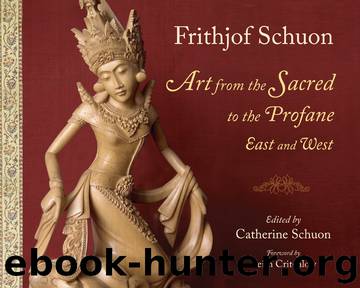Art From The Sacred To The Profane: East by Schuon Frithjof

Author:Schuon, Frithjof
Language: eng
Format: epub
Publisher: World Wisdom
In Christianity the sacred emanates from the sacrament, which confers upon the collective sense of the sacred its characteristic quality, notably the taste for solemnity, without forgetting the splendor of the liturgical art, such as the iconostases, the golden retables, and the priestly vestments.
Byzantine, Romanesque, and primitive Gothic arts are theologies: they proclaim God, or rather "realize" Him on a certain level.
118. His Beatitude Damianos, Orthodox Patriarch ofJerusalem, head of the Greek Church
The pseudo-Christian art inaugurated by the neo-paganism of the Renaissance seeks and realizes only man. The mysteries it should suggest are suffocated in a din of superficiality and inability, inevitable features of individualism; in any case it inflicts immense harm on society, above all by its ignorant hypocrisy. How should it be otherwise, seeing that this art is only disguised paganism and takes no account in its formal language of the contemplative chastity and the immaterial beauty of the spirit of the Gospels? How can one unreservedly call "sacred" an art which, forgetful of the quasi-sacramental character of holy images and forgetful, too, of the traditional rules of the crafts, holds up to the veneration of the faithful carnal and showy copies of nature and even portraits of concubines painted by libertines? In the ancient Church, and in the Eastern Churches even down to our own times, icon painters prepared themselves for their work by fasting, by prayer, and by sacraments; to the inspiration which had fixed the immutable type of the image they added their own humble and pious inspirations; and they scrupulously respected the symbolism—always susceptible of an endless series of precious nuances—of the forms and colors. They drew their creative joy, not from inventing pretentious novelties, but from a loving recreation of the revealed prototypes, and this resulted in a spiritual and artistic perfection such as no individual genius could ever attain.
In the sixteenth century the Patriarch Nikon ordered the destruction of icons influenced by the Renaissance and threatened with excommunication those who painted or owned such paintings. After him the Patriarch Joachim required—in his last will and testament—that icons should always be painted according to ancient models and not "follow Latin or German models, which are invented according to the personal whim of the artist and corrupt the tradition of the Church." Many texts of this kind could be cited.2
Download
This site does not store any files on its server. We only index and link to content provided by other sites. Please contact the content providers to delete copyright contents if any and email us, we'll remove relevant links or contents immediately.
Michelangelo And The Sistine Chapel by Andrew Graham-Dixon(1027)
Seven Secrets of Shiva by Devdutt Pattanaik(930)
Accounts and Images of Six Kannon in Japan by Sherry D. Fowler(925)
The Geometry of Love by Margaret Visser(921)
Saints, Shrines and Pilgrims by Roger Rosewell(895)
The Mushroom in Christian Art by John A. Rush(888)
Resurrecting Easter by John Dominic Crossan(872)
The Lost Painting by Jonathan Harr(868)
Buddhism Illuminated by San San May Jana Igunma(855)
THE FRESCO by The Fresco(852)
Ayala's Angel by Anthony Trollope(820)
Illuminated Manuscripts by Richard Hayman(820)
The Handbook of Tibetan Buddhist Symbols by Robert Beer(795)
Creating Personal Mandalas by Cassia Cogger(789)
Silence and Beauty by Makoto Fujimura(772)
Moon by the Window by Shodo Harada(746)
Dharma Delight by Rodney Alan Greenblat(734)
Saint Paul by Pier Paolo Pasolini(733)
Art From The Sacred To The Profane: East by Schuon Frithjof(732)
